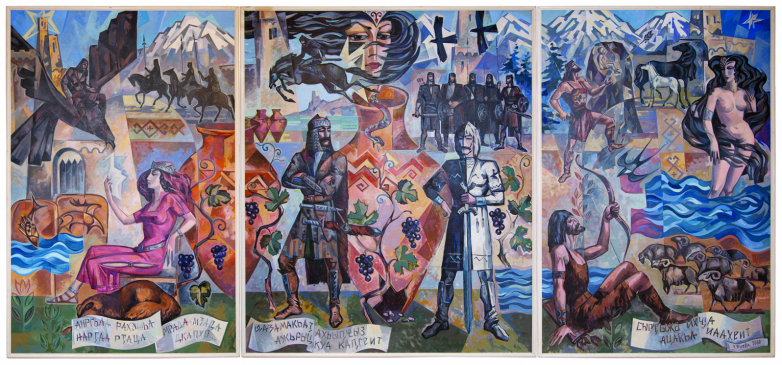Ethnographers told the WAC about the traditions of the ancient Abkhaz holiday Azhirnykhva - the so-called “Creation of the World” day, which falls on the “Old New Year”.
Said Bargandzhia
“Old New Year” - linguists will call this phrase an oxymoron, that is, a combination of words denoting opposite concepts. Children and the younger generation will not immediately understand its meaning. In fact, everything is simple: from 13 to 14 January in Abkhazia, Russia, the countries of the former USSR and other countries, the New Year would have been celebrated if at one time these countries had not switched to another calendar, to a new system of chronology. That is, the “Old New Year” is the beginning of a new calendar year according to the old style.
Different calendars and diverse traditions
The difference in the calendars is connected with many interesting facts and established traditions. One of the most striking examples is the annual cycle of holidays of the Orthodox Church in a number of states, including Abkhazia: church holidays are still celebrated according to the Julian calendar. Therefore, for example, Orthodox Christians celebrate Christmas on January 7, while it is celebrated on December 25 in Catholic countries. In Tsarist Russia, which lived according to the Julian calendar, Christmas preceded the secular New Year - the very one that now falls on January 14th and is called the “old” one. Today, in the period of secular New Year holidays, Orthodox Christians, including in Abkhazia, are holding a Christmas fast.
Old New Year is celebrated in many countries. Everywhere, the emergence of a “strange” holiday is connected with the transition to another calendar, but the features and traditions of this day stem from the mentality, culture, and often the religious beliefs of residents of a particular country. For example, in some areas of Switzerland, St. Sylvestre Day is celebrated: residents celebrate it extensively, dress up in fancy dresses. Carnivals are organized on this day and in Macedonia. In Wales, the festival Hyun Galan, which also falls on the beginning of the New Year on the Julian calendar. On this day, children go home and get sweets for small performances.
There are even specialized exhibitions devoted to the traditions of celebrating the Old New Year: they are held by museums and cultural organizations. There is such an exposition in the Abkhaz State Museum.
Old New Year, Nart Epos and Blacksmithing
The hammer, the anvil, the special attributes of the blacksmith's craft ... A visitor to the Sukhum museum who is not familiar with Abkhaz culture will not immediately realize that all these objects somehow correlate with the celebration of the Old New Year. It turns out that this day is the so-called holiday of “the creation of the world” - Azhirnykhva (Ажьырныҳәа in Abkh. - ed.), associated with the ancient Abkhaz beliefs. And those, in turn, are associated with blacksmithing. Among the deities worshiped by the Abkhaz thousands of years ago was the god Shashvy (Шьашәы in Abkh. - ed.). According to the ideas of the ancient Abkhaz, this deity patronized blacksmithing. Blacksmiths were irreplaceable masters of the ancient Abkhaz, this skill was highly valued.
In the Nart epos one can read the description of an incredible action: a newborn boy is dipped into liquid steel. However the boy, according to legend, was not a simple one. It was the famous nart Sasrykva: carved out of stone, he was attached to the body of Satanei-Gouashi (central character of the Abkhaz Nart epos, mother of a hundred Nart brothers and their only sister Gunda - ed.) and “revived”. The epos tells that the Nart blacksmith Ainar-zhi tempered him in the furnace of the forge.
In the old days many Abkhaz people wanted the son of a family to become a good blacksmith, and far not everyone could become such. They tried to “entreat” the deity of Shashvy about it.
Thus, the forge or smith from antiquity among the Abkhaz was considered a sacred place, especially among families engaged in blacksmithing from generation to generation. Such families had tribal forges (Azhiira in Abkh. - ed.). On the day of Azhirnykh, it was there that the family gathered to celebrate the holiday.
Inga Shamba, a senior researcher at the ethnography department of the Abkhaz State Museum, says that azhiira was built on a hill, not too close to the house, to its right. The forge was supposed to "look" in the direction of the sunrise.
“Previously, it was not customary to cover the smithy with a roof, it was placed under a large tree under the open sky. Now azhiira is covered with a roof,” the ethnographer notes.
Azhirnykhva today
Today a large number of Christians live in Abkhazia, there are families professing Islam and other religions. Of course, the holiday of Azhirnykhva is celebrated by not everyone: the question of faith is a personal matter and the choice of each person. Thus, Christians with a conscious faith in the Only God, the Holy Trinity and Christ the Savior will not participate in the pagan feast, even by tradition. So, it can be said with confidence that today, the holiday of Azhirnykhva in Abkhazia is celebrated either by conscious adherents of the ancient Abkhaz religion, or by secular people who are not serious about any religion at all.
An ethnologist, Ph.D Valery Biguaa also says about it, in particular,. He believes that for modern Abkhaz, especially the young, the cult of Azhirnykhva is "more a tribute to customs than faith in its miraculous powers."
“This is more a reason for meeting and intimate communication of relatives than a religious cult. It is held solemnly, cheerfully, and noisily,” says the ethnologist.
Tribute to customs
In its ritual part, the festival of Azhirnykhva largely preserved the customs of antiquity. It is celebrated mainly in ancestral homes in rural areas.
Many Abkhaz moved to live in the cities, but a close relationship with the village remained. Someone like with parents in the villages, someone left the parental home or family cemetery, which the Abkhaz regularly visit. On Azhirnykhva they gather in family houses and celebrate the holiday.
Inga Shamba says that on the eve of the Old New Year after sunset the members of a family sacrifice an animal: most often it is a goat, sometimes a young goby.
“It is important that the animal is more than two years old and clean, that is, there should not be any stains on it. Also, for each family member, depending on the sex, a chicken or a rooster is sacrificed,” says the ethnographer.
According to Shamba, the meat of the animals is first boiled, and then, after dark, all family members — bearers of the same surname — go to the sanctuary, which is the forge. In most cases, the modern patrimonial forge is already symbolic and does not function as a workshop.
The girl who left the house and married, as well as her children, has no right to go to the smithy. The ethnologist says that the family brings to the smithy the cooked meat of the sacrificial animal, also its horns and skin, boiled chickens and roosters, small round cakes made from dough and stuffed with cheese and red wine. White wine is not used.
In the forge, family members line up in a semicircle, and prayers begin. The ethnographer notes that while the prayer holds a large nut stick with a heart and liver of a sacrificial goat or bull in his left hand and a glass of wine in his right. In ancient times it was a priest, at a later time, the status of a prayer became hereditary: from father to eldest son.
“The eldest in the family utters a prayer for the well-being of the family,” explains Shamba. –By tradition, after that, others in seniority say a prayer and taste the liver and heart of the sacrificial animal. The priest says a prayer for each family member and lights a candle in his honor, which he then leaves at the forge itself. Candles are made by family members themselves.”
In conclusion, the ethnographer noted that everyone today has the opportunity to come to the Abkhaz State Museum, visit the exposition of Azhirnykh and learn what traditions of this holiday have been preserved since ancient times, which have changed, and which have completely sunk into oblivion.



to login or register.